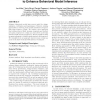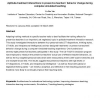5054 search results - page 13 / 1011 » How designers design and program interactive behaviors |
ICSE
2010
IEEE-ACM
15 years 4 months ago
2010
IEEE-ACM
Software behavioral models have proven useful for design, validation, verification, and maintenance. However, existing approaches for deriving such models sometimes overgeneraliz...
AC
2003
Springer
15 years 4 months ago
2003
Springer
Abstract. We describe InterPlay, a simulation engine coordinator that supports cooperation and interaction of multiple simulation and execution tools, thus helping to scale-up the ...
133
click to vote
SIGCSE
2002
ACM
14 years 11 months ago
2002
ACM
Empirical evidence shows the ability for computer technology to deliver on its promises of enhancing our quality of life relies on how well the application fits our understanding ...
CE
2007
14 years 11 months ago
2007
Adapting training methods to specific teacher traits to best facilitate the training effects for preservice teachers is an important, yet neglected, topic in aptitude-treatment in...
185
click to vote
Book
""The goal of this book is to teach you to think like a computer scientist. I like the way computer scientists think because they combine some of the best features of Mat...




